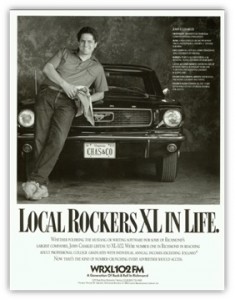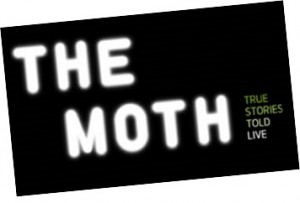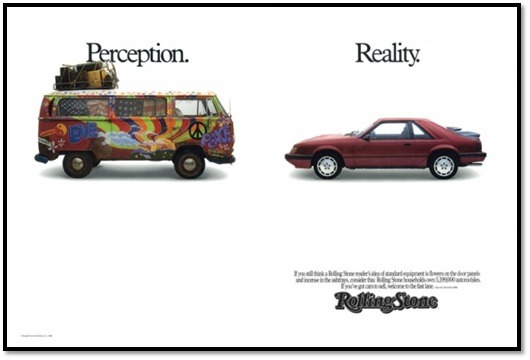We’ve all been there. You work for a brand – or in the case of many people who read this blog – a radio station that is misunderstood and undervalued by advertisers.
This radio problem very likely pre-dates Don Draper because radio stations are always in some sort of struggle with the “Mad Men” (and women) who appropriate ad dollars on behalf of their unknowing clients.
In the case of radio, every format seems to come with built-in stereotypes and biases, most of which are simply unfounded.
Country has often lost out because of perceptions that its audience is downscale.
Rock radio has been punished for being associated with black T-shirted young males and profane morning shows.
And Urban stations have….well, they’ve just unfairly suffered – period.
And by and large, these per ceptions, preconceptions, and biases can haunt a local station in its marketplace for decades.
ceptions, preconceptions, and biases can haunt a local station in its marketplace for decades.
Many years ago, I worked for WRXL/Richmond, better known as XL102. Back in the mid ‘80s, the ratings were great but sales were not commensurate. Problem was, advertiser perceptions were still rooted in the Hair Band phase the station had gone through.
So Claire Shaffner, the determined GM of the station, took matters into her own hands and created a series of ads that were placed in the market’s slick, yuppie-targeted magazine, Style Weekly (pictured left).
And the campaign worked. Over time, advertiser attitudes mellowed and morphed, and they began to see the station in a different light.
Not surprisingly, Rolling Stone battled the same problem – in spite of its influence as the music publication of record in the ‘60s and ‘70s. They dreamed up a series of ads to address the perception vs. reality dichotomy head on, depicting what advertisers thought of their magazine, and then correcting it with a more pleasing, desirable image.
Even when your metrics are desirable, if the ad community has a different opinion, then marketing and positioning are needed. The Rolling Stone ads took a humorous approach, but the message was as serious as a heart attack:
Don’t underestimate our audience.
That’s what you have to do when the numbers are on your side, but the emotions of the buyers, planners, and decision-makers overpower the data. And to a great degree, isn’t that the problem radio as an industry continues to face in the perceptual battle that is tainting opinions and attitudes of both consumers and advertisers?
And ultimately, the up and coming, young, college educated workforce is affected, too. If they believe that radio is passé and has seen better days, it’s all the more reason for them to take a different career path, venturing off to hipper, modern media jobs.
You may have seen a new study by Advertiser Perceptions. It tells the sad but familiar story that radio reach is very much undervalued by the people that matter most – those 327 surveyed execs who hold the purse strings at the agency level.
93%? Hardly. They think that less than two-thirds of Americans listen to radio every week. And in the minds of these agencies, they see parity between broadcast radio, Pandora, and Spotify, even though radio stomps these digital channels in terms of true reach.
Numbers may not lie. But rarely do they convince. If attitudes and opinions are entrenched, people will simply reject the data because as we have learned throughout our lives, anybody can massage the numbers to prove a point, whether it’s politicians, car dealers, or radio stations.
Let’s also keep in mind that we’re not talking about the average person on the street in this study of media perceptions. These are advertising professionals who ought to have a better grasp of who’s consuming which media in America. Sadly, even they believe that radio is becoming an also-ran medium.
So why not try a different tact?
Why not tell the story of radio’s true impact – the effect it has on Americans in all 50 states?
It’s the morning show whose Christmas Wish brought you to tears when you heard how they helped a local family in need.
That interview you heard that was so good you couldn’t get out of your car when you arrived at work.
The station that stayed on the air throughout the night when that tornado blew through town.
The afternoon guy who arranged the meet-and-greet with your favorite new band.
The big sports game your whole family enjoyed while driving to your cottage this summer.
The talk show host who reminded you that despite the turbulence and division, America is still the greatest place to live on Planet Earth.
 At a time when the big thing in media and business is storytelling, radio does precious little of it on its own behalf. “The Moth Radio Hour” has become a go-to destination in public radio circles. It has a similar format to stand-up comedy, but the person on stage with a mic is telling a very personal story to a live audience that grabs you and holds you.
At a time when the big thing in media and business is storytelling, radio does precious little of it on its own behalf. “The Moth Radio Hour” has become a go-to destination in public radio circles. It has a similar format to stand-up comedy, but the person on stage with a mic is telling a very personal story to a live audience that grabs you and holds you.
Sadly, the radio version of this would be a bookish looking executive walking out on a stage, reading a spreadsheet. Get the hook.
For an industry that prides itself on its marketing savvy, radio should be applying the same principles to its own product. If “Client Radio” came to you with the sad story of how nobody believes its numbers decades of great performance, I bet you’d suggest taking a different tact.
I have long advocated an industry S.W.O.T. analysis – something that the NAB, the RAB, and radio’s best companies could undertake. If it’s moderated professionally, it’s an exercise that ought to lead to a sound and effective way forward. It’s a process that helps stakeholders gain new perspective on its brand, and it usually works. It might be wise to include some smart agency people and let them help solve radio’s problem, too.
Don Draper would have relished this assignment because after a martini or two, he’d solve this not-all-that-complicated problem for “Client Radio.”
To our health.
- What To Do If Your Radio Station Goes Through A Midlife Crisis - April 25, 2025
- A 2020 Lesson?It Could All Be Gone In A Flash - April 24, 2025
- How AI Can Give Radio Personalities More…PERSONALITY - April 23, 2025





Great discussion, Fred. In the case of radio, you can talk all you want about off-the-charts audience numbers, but it all comes down to results. In sales, you can be discouraged over a small number of leads, but the attitude changes if just a couple of them convert into real business. That’s why your statement that radio needs great stories is so relevant. Who knows how many listeners we’ve told advertisers they’d get – and who cares, as long as the work we do for them gets the right listeners and the right results. Asking agency executives anything in a somewhat small sample is always intriguing but dangerous. We did the same thing recently in our survey on what they thought about the quality of creative work out there. Fortunately, their responses were interesting food for thought rather than us having to go back to the playbook and rethink our corporate strategy. Thanks again for moving this topic to the forefront.
Jim, appreciate it and thanks for your perceptive comments. Agencies and advertisers are the target. Their feelings and ideas can be very helpful.
It’s good to see that we are finally dealing with the true issue..”THEY” don’t believe “THEY” are listening anymore!
Every presentation to a new client that we do starts with this simple question..”How many Americans in a typical week listen to at least one local radio station?” The answers have been eye opening as I would consider that 60-65% number cited in the research piece to be higher than what we have experienced.
Until this perception is dealt with, nothing else matters.
No doubt about it, Ed. Thanks for adding to the conversation.
I continue to believe that this is a macro problem with a micro level solution. Selling media is (or should be) about solving a business problem for someone via some method that they believe will work and can afford. The fix here is one buyer/planner/account supervisor/Media Director at a time. Meet with them, learn what keeps them up at night – and if/when radio is a useful solution, THAT’S WHEN you show em how many people radio really reaches. But do that knowing all they care about is reaching the people that will solve their problem. Radio has always believed that it was a reach medium, but in my experience it was rarely if ever bought that way. Targeting was the reason most people bought radio when no one doubted its reach.
Radio loves to think macro efficiencies are the answer to all of its problems, when in fact they are the source of most of them. Change that thinking and the problem may well solve itself.
You make some great points based on your front line experience sitting with media buyers and advertisers. It’s not about reach, it’s about results. Thanks, Bob.
“If you don’t like what is being said, then change the conversation.” – Don Draper
You don’t see Apple, Coca-Cola or McDonald’s trying to convince the world they are still relevant. They all advertise – a lot – and rely on those advertisements to define their reputations. Radio needs to do the same. The top rated radio show in a market doesn’t stay on top by telling the audience how many people listen to their show. Instead they entertain them and not only do the listeners keep coming back but they tell other people to tune in also.
One of the things I love about your examples Fred are that the advertisements in them went beyond radio. Of course it’s important to promote the product on our own medium but it’s equally important to find the audience other places. When done well promotions elsewhere can have more impact because they seem less self serving.
Radio makes personal connections and has the reach now it’s time to advertise that it in a fun, positive way.
And I love the Don Draper quote. There was a lot of marketing brilliance on the show if you got past the martinis. Thanks for adding to the conversation, Sean.
Who told those execs or how did they get that impression. Are you saying it creeped in for lack of telling them how good radio was: Like we used to do with, “Radio. It’s Red Hot” ads that used to run? I’m wondering just how that perception grew? Was it Pandora and people like that telling them? Thanks Fred.
Robin, to some degree, radio may have taken its legacy for granted and may have also under-estimated the impact of new media competitors. Thanks for the comment.
Agreed also as you probably are aware of what Eric Rhoads said on the front page of the DASH site – about the car dealers and the melinnials taking over. I think this may be a growing and pervasive perception problem that could be beyond help. Thanks!
We’ll be talking about ALL these issues at DASH, Nov.4-5 here in Detroit.
Find a need and fill it, lol.
https://www.advertiserperceptions.com/